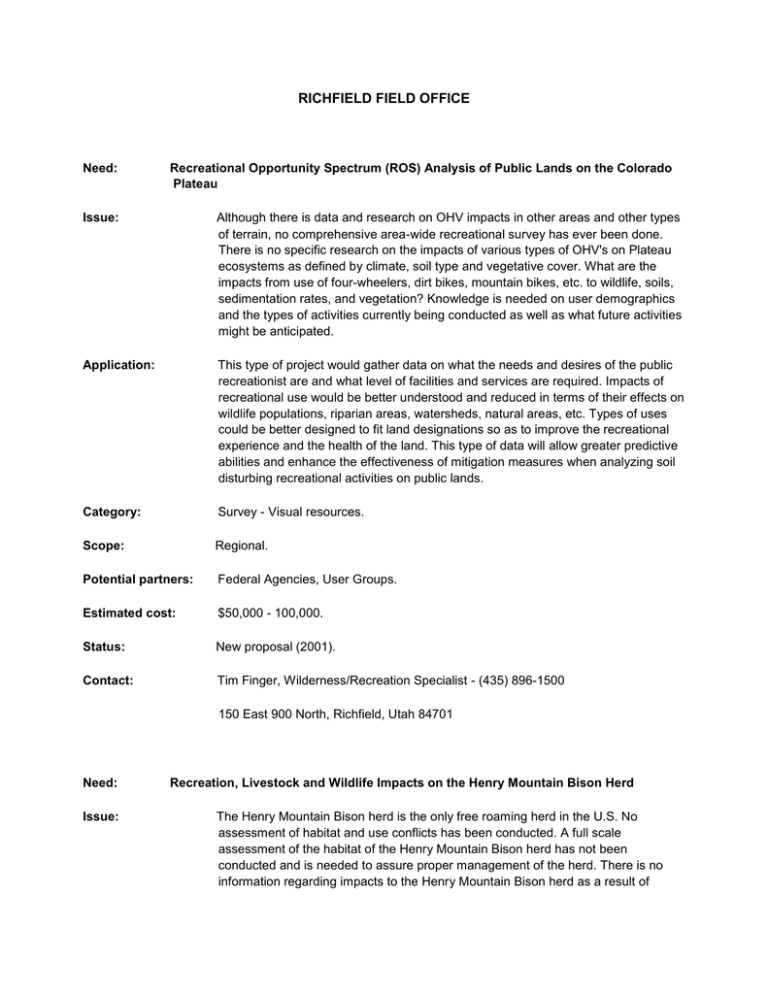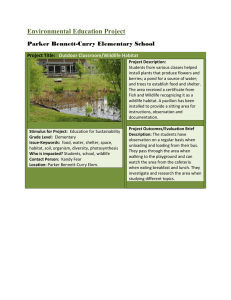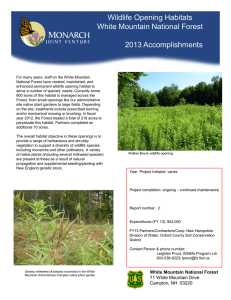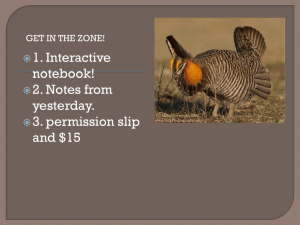Richfield
advertisement

RICHFIELD FIELD OFFICE Need: Recreational Opportunity Spectrum (ROS) Analysis of Public Lands on the Colorado Plateau Issue: Although there is data and research on OHV impacts in other areas and other types of terrain, no comprehensive area-wide recreational survey has ever been done. There is no specific research on the impacts of various types of OHV's on Plateau ecosystems as defined by climate, soil type and vegetative cover. What are the impacts from use of four-wheelers, dirt bikes, mountain bikes, etc. to wildlife, soils, sedimentation rates, and vegetation? Knowledge is needed on user demographics and the types of activities currently being conducted as well as what future activities might be anticipated. Application: This type of project would gather data on what the needs and desires of the public recreationist are and what level of facilities and services are required. Impacts of recreational use would be better understood and reduced in terms of their effects on wildlife populations, riparian areas, watersheds, natural areas, etc. Types of uses could be better designed to fit land designations so as to improve the recreational experience and the health of the land. This type of data will allow greater predictive abilities and enhance the effectiveness of mitigation measures when analyzing soil disturbing recreational activities on public lands. Category: Survey - Visual resources. Scope: Regional. Potential partners: Federal Agencies, User Groups. Estimated cost: $50,000 - 100,000. Status: New proposal (2001). Contact: Tim Finger, Wilderness/Recreation Specialist - (435) 896-1500 150 East 900 North, Richfield, Utah 84701 Need: Issue: Recreation, Livestock and Wildlife Impacts on the Henry Mountain Bison Herd The Henry Mountain Bison herd is the only free roaming herd in the U.S. No assessment of habitat and use conflicts has been conducted. A full scale assessment of the habitat of the Henry Mountain Bison herd has not been conducted and is needed to assure proper management of the herd. There is no information regarding impacts to the Henry Mountain Bison herd as a result of recreation use. Is the increased recreation use causing bison to alter traditional seasonal use patterns? Is recreation use having any impacts during breeding and calving seasons? Is there any conflict and/or overlap of forage consumption between livestock and bison? There is a need to determine optimum carrying capacity numbers for each species in terms of range conditions. Currently the Bison have moved into new ranges where there is little forage allocation. There is also no forage allocation for wildlife in these areas. Application: Currently there is little information on the movement patterns of these species within the Henry Mountains or their impacts to the range. Gathering this data will allow proper management of the Henry Mountain bison herd and other native species and address mitigation for conflicts between different users in the Henry Mountains. Category: Research - wildlife, recreation impacts. Scope: Local. Potential partners: UDWR. Estimated cost: $50,000 - 100,000. Status: Contact: New proposal (2001). Gary Hall, Assistant Field Office Manager - (435) 896-1500 150 East 900 North, Richfield, Utah 84701 Need: Issue: Habitat Characteristics and Assessment for Northern Goshawk, Mexican Spotted Owl and Southwest Willow Flycatcher Detailed assessments for each of these species in this area is currently unavailable. Such information is needed for planning purposes. We would like to examine and conduct an assessment of the habitat characteristics for Northern Goshawk, Mexican Spotted Owl and Southwest Willow Flycatcher within the Henry Mountain Field Station. These species are federally protected and management is directed by recovery plans. Critical habitat designations have been made for the Mexican Spotted Owl. A full assessment of what is nesting, roosting and foraging habitat is needed for each of these species. A determination regarding impacts from associated activities and mitigation for such impacts is needed. Determinations for restoration of declining habitats is also needed Application: Information would be used by other agencies and academia. This type of research and monitoring would assist BLM in long-term management of these species and their habitats and would assure sustainability of each species and such habitats. Category: Research - wildlife, T&E species, habitat assessment. Scope: Regional. Potential partners: UDWR, Academia, Other Agencies. Estimated cost: >$100,000. Status: New proposal (2001). Contact: Lori Armstrong, Resource Advisor - (435) 896-1500 150 East 900 North, Richfield, Utah 84701 Need: Habitat Characteristics and Assessment for Utah Prairie Dog on the Parker Mountain Issue: Detailed assessments for Utah Prairie Dog on the Parker Mountain is currently unavailable. Such information is needed for planning purposes. We would like to examine and conduct and assessment of the habitat characteristics for Utah Prairie Dog on the Parker Mountains. This species is federally protected and management is directed by recovery plans and conservation strategies. A full assessment has not been conducted of habitat characteristics located on the Parker Mountain. Utah Prairie Dog populations have fluctuated over decades and it is not known whether those fluctuations on Parker Mountain are a result of disease or alteration in habitat characteristics. A determination regarding impacts from other activities, specifically livestock grazing and mitigation for such impacts is needed. Determinations for restoration of declining habitats is also needed. Application: Information will be used by other agencies and academia. This type of research and monitoring would assist BLM in long-term management of this species and its habitats and would assure sustainability of such. Category: Assessments - wildlife, prairie dogs, T&E species, habitat impacts. Scope: Local, with potential regional application. Potential partners: UDWR. Estimated cost: $50,000 - 100,000. Status: New proposal (2001). Contact: Lori Armstrong, Resource Advisor - (435) 896-1500 150 East 900 North, Richfield, Utah 84701 Need: Seasonal Use Areas and Preferred Use Areas of Desert Bighorn Sheep Issue: The identification of suitable range and the carrying capacity for Desert Bighorn sheep is needed. A full scale assessment of the habitat within the drainages of the Dirty Devil River is needed. Such information will assist with management decisions for maintenance of habitat and for determinations regarding potential conflicts with livestock and other uses. Is there any conflict between the extent of conflict and overlap of forage consumption between livestock and Desert Bighorn sheep? Application: This type of analysis and data will allow proper management of Desert Bighorn Sheep within the Dirty Devil watershed along with mitigation for conflicts between different users. Category: Inventory and assessment - wildlife, Desert Big Horn sheep. Scope: Local, with some application regionally. Potential partners: UDWR. Estimated cost: $50,000 - 100,000. Status: New proposal (2001). Contact: Gary Hall, Assistant Field Office Manager - (435) 896-1500 150 East 900 North, Richfield, Utah 84701 Need: Control of Invasive Tamarisk in Critical Wildlife Habitat Areas Issue: Invasive Tamarisk is rapidly spreading in watersheds throughout the Colorado Plateau, including critical habitat for a number of key species of concern including Desert Bighorn Sheep, Mexican Spotted Owl, Southwest Willow Flycatcher and others. Wildlife populations, species diversity and naturalness are being adversely affected. An effective small-scale management project is needed in high priority, site specific locations (seeps, springs and riparian corridors). This project, using a range of biological, chemical and mechanical methods would gather information on success rates per effort while reducing impacts to natural systems. Application: This data will allow enhanced knowledge of watershed restoration techniques in areas of critical wildlife habitat which have been invaded by Tamarisk and improvement of native habitats for many protected species. Information will provide for management of riparian corridors and will meet T&E species mandates Category: Research - wildlife, invasive species, restoration experimentation. Scope: Regional. Potential partners: UDWR, Academia, Chemical Companies. Estimated cost: Total $50,000 - 100,000. Status: New proposal (2001). Contact: Lori Armstrong, Resource Advisor - (435) 896-1500 150 East 900 North, Richfield, Utah 84701 Need: Completion and Publication of NRCS Order 3 Soil Surveys within Wayne County, Utah Issue: Order 3 Soil Surveys have been completed throughout much of Utah, and areas remaining for completion have not been done do to costs and remote nature. NRCS cannot complete these areas in a timely order without financial assistance. Application: Order 3 soil survey information is needed to assess site characteristics and ecological capacity. This is a critical base data layer for determining a variety of resource values and potential uses and impacts for a variety of programs. Category: Baseline inventory - soils. Scope: Local. Potential partners: NRCS. Estimated cost: $.50/acre, over 100,000 acres. Status: New proposal (2001). Contact: LaRell Chappell, Soil Scientist - (435) 896-1500 150 East 900 North, Richfield, Utah 84701 Need: Sagebrush Steppe Habitat and Avian Population Dynamics and a Bibliography of Previous Research Issue: Examine the habitat characteristics of sagebrush on different sagebrush obligate bird species. Such assessments are especially critical for the Sage Grouse which is currently under consideration for federal listing. Application: Research and monitoring would assist BLM in long-term management of avian habitat in sagebrush steppe communities and would assure sustainability of such habitats. Category: Research - sagebrush steppe habitat, sage grouse. Scope: Regional. Potential partners: UDWR, NRCS. Estimated cost: $100,000. Status: New proposal (2001). Contact: Lori Armstrong, Resource Advisor - (435) 896-1500 150 East 900 North, Richfield, Utah 84701 Need: Pinon and Juniper Encroachment into Sagebrush Communities Issue: Many factors have led to the increase in the density of Pinon-juniper throughout the West. What has precipitated are vast areas once dominated by sagebrush, sagebrush/grasslands are now dominated by Pinon-juniper. As Pinon-juniper increases in density less opportunity exists for palatable, more desirable species to occupy the landscape. Wildlife species dependent on the forage in a sagebrush community lose grass, forbs, and browse species to the encroachment of Pinonjuniper. Application: Regional scale, information will be used by other agencies and academia and a variety of different programs. This type of research and monitoring would assist BLM in long-term management of sagebrush steppe communities and would assure sustainability of such communities. The implementation and completion of such a project would allow land managers more opportunity to maintain and/or restore sagebrush communities and the wildlife populations that are tied to these communities. Category: Research - vegetation, sagebrush, piñon- juniper, wildlife. Scope: Regional. Potential partners: NAU, USGS, NSTC. This issue and need have been incorporated into the BLM Colorado Plateau Pinon-juniper Strategy. NSTC is also providing assistance in bibliographic research. Estimated cost: > $100,000 but proposal can be broken into smaller discrete projects likely running between $5,000 - 10,000. Status: New proposal (2001). This issue and need have been incorporated into the BLM Colorado Plateau Pinon-juniper Strategy. NSTC is also providing assistance in bibliographic research. Contact: Lori Armstrong, Resource Advisor - (435) 896-1500 150 East 900 North, Richfield, Utah 84701 Need: Effective Vegetative and Physical Reclamation Techniques on the Colorado Plateau, and a Bibliography of Past Research Issue: Increasingly, programs are initiated for restoration of abandoned minesites and watersheds. The Colorado Plateau has a unique assemblage of soil and vegetation types, combined with unique climatic and precipitation patterns. What vegetative species have the best chance of survival if used in reclamation given these characteristics? Is it better to use native species, which are more difficult and expensive to acquire and work with, or are there non-native species that may work without adverse impact? Should vegetative species be acquired from local areas so that they are acclimated to local climatic patterns? What types of soil characteristics govern success, or require additional treatment prior to revegetation. Application: Regional scale, information will be used by other agencies. This type of information would greatly enhance restoration and reclamation efforts, resulting in cost savings in time and materials, and result in enhanced success of reclamation. Category: Data acquisition - bibliography, reclamation treatments. Research - reclamation. Scope: Regional. Potential partners: NSTC, USGS, academia. Estimated cost: $10,000 - 25,000 per project. Status: New proposal (2001). Contact: Lori Armstrong, Resource Advisor - (435) 896-1500 150 East 900 North, Richfield, Utah 84701






